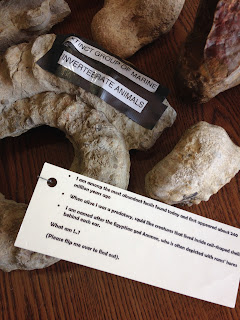We visited Austin Nature and Science Center while on vacation over the break! We have ANCA reciprocity through Woodlawn Nature Center for many nature centers (great perk!); however, this one is FREE! What a great resource for the community! I loved the entryway of sculpted branches!

As we entered, I noticed the Earth Healing sign--I thought this was a nice touch and good reminder to let certain areas not get trampled. I always like checking out the maps and the layout of the area.
There was a Little Free Library (love these!) just outside of the dedicated Nature's Way Preschool area. I would have loved a tour of the nature preschool, but did peek through the fence. I like checking out how they structure sessions in various areas, too.
The nature preschool area looks like a place to explore outside, with room to work on projects on the tables outside, places to get creative, and room to play. I like that it didn't look "pristine", but actually looked like a place that is used and adored by the children.
In nearby public spaces, they had several areas with natural elements as an invitation to play!
They also encouraged and modeled pollinator habitats. We are working on that more at our house, having just planted a bunch of perennial pollinator plants this fall. Hopefully they do well this spring and summer!
As we approached the center, mosaics welcomed us to explore. There was a working honeybee hive inside the building, allowing us to see how busy bees really are.
There were numerous shelved cabinets like this with bones, rocks, and other items to explore like this. Most had labels were a good addition. It looks like the cabinets might have been repurposed and fitted with clear plexiglass covers and locks to protect the components. There were also big tables of STUFF for exploration and learning. Several had laminated "clues" tied to the specimen with string which helped us learn more about the objects.
One aspect I liked that I have been looking into is a trade counter. These items were housed on various shelves, with points assigned to each object. As you earned points by bringing in additional trade items, you could use the points for new objects. Pretty cool! They inform the users on good collecting techniques and keeping collecting sustainable as well as following regulations.
I've seen this nano panel at a few places recently! There were exhibition aspects throughout the grounds, such as the rainwater harvesting, solar panels, and more.
What the kids really enjoyed, was the creek running through the area. They could have stayed all day, though we found a nearby dino digging pit AND had other cool places to visit.
There were live animals outside in cages and another building with animals from the area. We don't get to see a bobcat that close up very often. :-)
The entrance to the dino digging pit was cool! There were shovels, diggers, and brushes to help uncover the hidden dinosaur, sea creature, and ice age creatures buried in the sand. This was a popular area!
Even the oldest found joy in discovering the fossils!
One boy really wanted to climb anything and everywhere he could find. This was a hilly area throughout the nature center, so he was climbing lots of things!
There were several distinct areas for digging, each with a different focus.
There were interpretive panels and a field journal of the dig nearby as well. This added to the learning experience.
They had lots of fun!
As we left, I noticed this list of what was found at the center, kept up by Master Naturalists from the area.
There was a Science Discovery area, with activities on sorting rocks. I liked the trays with information sheets on each. I'll have to make something similar soon! I'm always looking for good ideas as we visit places.
We found more climbing/play areas as we left. Who needs a playground?
We absolutely loved this tree! Glad they could keep it as part of the experience! The Austin Nature and Science Center was a great place to visit. We could have stayed much longer. If you're in the area, check it out. If you're elsewhere, check out your local nature centers to see what they might have to offer. Also, as you travel, see what natural spaces (like nature centers) may be nearby--they are usually inexpensive (or free with reciprocity), have a bit of local flavor, and can be a great way to connect to nature!
































